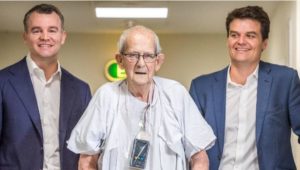Heart Surgery Breakthrough
Mildura Cardiology’s Dr Matthew Brooks – has performed an Australian-first operation.
Mildura Cardiologist Dr Matthew Brooks (who is married to a Mildura girl) and Dr William Wilson have performed a procedure known as the ‘BASILICA technique’ at The Royal Melbourne Hospital – previously only performed in North America.
Photo and story courtesy of The Herald Sun:
A grandfather with a failing heart and no traditional option to help him has been saved in an Australian-first operation.
Roger Reinhardt, 88, was back on his feet a day after having a new valve placed inside a leaking valve he received during open heart surgery 12 years ago, but which was now threatening to cut off blood to his heart.
Mr Reinhardt’s surgeons at the Royal Melbourne Hospital hope the success of Friday’s operation will open the door to saving others who could not previously be saved with modern valve replacement techniques.
With palliative care seemingly the only option for Mr Reinhardt when his old heart valve failed a fortnight ago, the Bairnsdale grandfather of 11 was offered the chance to see if a new operation could save his life.
“I am privileged to be able to do this for them,” Mr Reinhardt said. “I had become very, very short of breath and it happened gradually over four or five weeks before it got to the stage I could hardly breathe at all.”
A technique called transcatheter aortic valve replacement (TAVR) — where a catheter is used to push the valve into place inside the worn-out valve and take over its job — has become common in recent years to save patients in Mr Reinhardt’s condition.
But, like 3 per cent of such cases, Mr Reinhardt’s coronary artery is placed so close to the leaky valve that any attempt to replace it would push the device over the coronary opening and block blood supply to his heart.
Having investigated a new BASILICA technique being pioneered in the US to overcome the issue, Royal Melbourne Hospital cardiac surgeons Dr Matthew Brooks and Dr William Wilson gave Mr Reinhardt a new chance.
Passing an electrified wire through Mr Reinhardt’s femoral artery to his leaking valve, they cut a V-shaped gap in its side before passing a new valve along the same route and inserting it inside the old device.
Although the old valve blocked the coronary artery, its strategically placed gap allowed blood to keep flowing.
“He has been in hospital for weeks now and we haven’t been able to get him out so he would have been palliated,” Dr Brooks said.
“He became the first (for the surgery) because the timing was right: they have done a handful of cases overseas and his anatomy was ideal for this procedure.”


